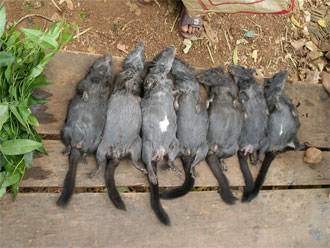Newly discovered rodent not so new or rare after all
Rhett A. Butler, mongabay.com
April 5, 2006
The newly discovered species of rodent found in a marketplace in Central Laos turns out to not be so new or so rare after all.
The Laotian rock rat (Laonastes aenigmamus), as the long-whiskered and stubby-legged rodent is now known, is a species believed to have been extinct for 11 million years. It is a member of a family that, until now, was only known from the fossil record.
Called Kha-Nyou by local people, the species (Laonastes aenigmamus) was first described by Wildlife Conservation Society (WCS) researcher Dr. Robert Timmins after it was found on a table at a hunter’s market in central Laos. In a return trip to the market, WCS conservationist Peter Clyne found the rats to be quite common, photographing several specimens. According to Clyne, the rat is commonly brought in by hunters and eaten by local people.
Scientists have yet to capture the strange rodent in the wild—the only specimen have come from the local meat market in Laos. Nevertheless, the discovery of such an ancient and unusual lends support to conservation efforts in the country, one of the poorest in Asia. WCS is working to address the illegal wildlife trade, which has devastated animal populations in Laos.
 Several feshly killed kha-nyou in hunter’s market in Laos. Photo credit: Peter Clyne of the Wildlife Conservation Society (WCS). |
George Schaller, a naturalist with WCS and also a well-known author says that the focus on the rodent will be “wonderful for conservation. This way, Laos will be proud of that region for all these new animals, which will help conservation in that some of the forests, I hope, will be preserved.”
The rodent is just one of several prominent animal species to be discovered in the region in recent years. Scientists also photographed a strange carnivore in Borneo and found a number of new species in a survey of rainforests in New Guinea.
Related articles
In search of Bigfoot, scientists may uncover unknown biodiversity in Malaysia
Malaysian scientists are scouring the rainforests of Johor state in search of the legendary ape-man Bigfoot, supposedly sighted late last year. But they are more likely to encounter some less fantastic but unique creatures that dwell in these still unexplored ecosystems.
Mysterious carnivore found in Borneo rain forest
Scientists may have discovered a new species of fox-like mammal in the rainforests of Borneo. The animal was caught on film by an automatic infra-red camera positioned in the forest of the Kayam Menterong National Park in the Indonesian section of the island during a survey by the World Wildlife Fund (WWF). Scientists say the animal is has a reddish-colored coat, a bushy tail, and slightly extended back legs, suggesting that it may be partly arboreal. Local hunters failed to recognize the creature from the pictures.
Pictures of newly discovered species in New Guinea
A team of scientists led by Conservation International (CI) found dozens of new species in a survey of New Guinea’s Foja Mountains. The December 2005 trip by a team of U.S., Indonesian, and Australian scientists discovered new species of frogs, butterflies, plants, and an orange-faced honeyeater, the first new bird from the island of New Guinea in more than 60 years. The discoveries were made under CI’s Rapid Assessment Program (RAP) which deploys expert scientists to poorly understood regions in order to quickly assess the biological diversity of an area. The conservation organization makes RAP results immediately available to local and international decision makers to help support conservation action and biodiversity protection.